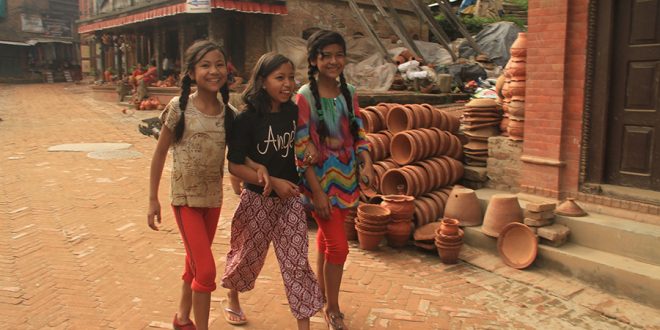Dashain is around the corner, and for me it brings about very fond childhood memories. This much-awaited festival signifies victory of good over evil. In this auspicious 10‐day festival, the nine days are celebration of various incarnations of goddess Durga, who defeats the demons and brings peace to ‘devalok’. The tenth day symbolizes her victory. A fierce and fearless warrior goddess, a savior with insurmountable power, a compassionate deity, protector and provider of divine justice, she is grace, kindness, and wisdom personified to the good, and an embodiment of fear, chaos, and destruction to the malicious and the malevolent. She is Parmeshwari (supreme goddess), Adi Shakti (first force of all creation), Para Brahma (ultimate truth), and Durga (invincible). She has an all encompassing role in Hindu mythology. She is Mahalaxmi (goddess of wealth), Mahasaraswati (goddess of knowledge), Mahagauri (fulfiller of desires) and Mahakali (destroyer of evil). She is the goddess of all gods, revered by Brahma, Vishnu, and Mahesh.
A tradition of goddess worship has been an integral part of our culture for ages. Be it Hinduism or Buddhism, we have for years worshipped female divinities. Very similar to Greek mythology, Hindu mythology has a pantheon of gods and goddesses. However, worshiping a goddess as the supreme of all supremes is unique to our culture. So, how did a culture so rich and empowering to women twist and tangle along the way that a very natural part of the reproductive process, menstruation, became a taboo? How does a religion that considers blood to be sacred (life source) and has temples dedicated to menstruating goddesses (Kamakhya Devi, Guwahati, and Chengannur Mahadeva Kshetram temple) consider women to be impure during their period? How does a tradition where girls are celebrated as goddesses expect their exclusion from certain aspects of social and cultural life?
Menstrual taboos are often associated with Hinduism. The first thing to be clear about is the fact that menstrual taboos are not part of Hinduism. It is true that they have somehow become an element of our culture and tradition and continues to survive inspite of legal and social changes in the name of religion. However, menstrual rituals are not based on religious scriptures, but are social constructs. The very early religious texts, the Vedas, the foundation of ‘Sanatan Dharma’ have never portrayed a menstruating woman’s body to be impure. The Vedas, which provide us with spiritual guidance and purpose in life, have never stated about any exclusion of menstruating women from certain aspects of social and cultural life. According to Vedic experts, “preventing women from doing ‘pooja’ and prohibiting them from entering temples and castigating them as impure is squarely against the teachings of the Vedas.” Women are assigned a higher place than men in these religious scriptures, owing to their sacred powers of fertility. Even gods are said to be incomplete without their female counterparts.
Menstruation is a natural and healthy part of a woman’s reproductive cycle. Something as natural as menstruation was not always looked down upon. Historically, menstruation was considered auspicious, and menstrual blood considered sacred, because it symbolized fertility and thus life. It was never considered impure or sinful, but powerful and healing. Very early menstrual practices in our culture lacked negative associations of stigma. Menstrual rituals came into play to empower a woman and show her compassion, understanding, and support, not to restrict her or to socially ostracize her or to make her weak. However, for years, these taboos have worked against women.
In early civilization, a lot of menstrual practices were based on ayurveda, a 7,000-year-old alternative medicine of natural healing, according to experts. Menstruation indicated the beginning of transition of girls into womanhood. A milestone in a woman’s life, something to be celebrated. Historically, a special safe hut was built for he, where she was kept separate, away from men, among other women, sisters, cousins, and friends, ensuring protection, comfort, and company. People usually lived in multigenerational, joint familes, and this would give her privacy to manage her periods, especially since there were no sanitary napkins in the past. She would not perform her daily household chores, so she could rest. Periods can be painful and uncomfortable. To a person who is not familiar with the culture, this may have seemed like forced exile and restrictions, but to those girls and women, it would have been much needed respite in a safe space. Her room would be kept relatively dark, because sleeping in darkness is supposed to improve fertility. Bathing rituals and laundry day were meant not to “purify her”, but to promote cleanliness and hygiene. Bathing on specific days, so that she was given privacy on those days as there were common bathing places in ancient times. Ayurveda says that during menstruation, ‘vata’ (one of the three primary life-forces in the body) is supposed to be the predominant ‘dosha’. Some foods were avoided to prevent constipation, bloating, diarrhea, or cramps, not as a means to restrict diet. Ayurveda believes every living being to be imbued with “prana”, the principle life energy. The restriction of flow of prana causes ailments. Women are said to be sensitive to energies around them during menstruation, so were advised to stay away from gatherings to avoid absorbing negative energy; hence, attending social events and functions was discouraged (not restricted). Temples were not visited not because she was “impure”, but for the same reason. A menstruating person is supposed to be at her highest power during menstruation. She was supposed to be sacred and a goddess herself, so in the Vedic era, women were not restricted from visiting temples. Not cooking, gardening, and touching crops, fruit trees, etc. were not because her touch would spoil them, but that they would interfere with her energy flow, according to ayurvedic experts. Restriction on sexual acts during menstruation was so she could make autonomous decisions about her own body.
So, how did a practice that was supposed to benefit females change in such a negative way? How, the very thing that was special about women throughout evolution signifying fertility is now supposed to be shameful and disempowering? If the original menstrual rituals were meant for boosting female strength, why and how did it change? Why did safe huts become forced exiles to ‘chhaupadi’ (banishment of women during menstruation from their home to a crude hut, usually an animal shed) a practice that has resulted in the deaths of several women each year. ‘Chhaupadi’ puts women at risk of animal attack, snake bites, sexual and physical assault, extremes of temperature, and suffocation due to lack of proper ventilation. Despite it being banned in 2000, and punishable by law in 2018, it is still believed to be in practice in far flung regions of Nepal. When were shackles put around women’s ankles so they could not be a part of religious festivals or social events? Why is she impure and should not visit a place of worship? Since when did she start praying to a partial god? Why did respite become restriction? Why did autonomy turn into rejection? Why, during her first period, a little girl feels vulnerable and scared instead of special? Where is the support, as her body is going through hormonal changes? Why, somewhere along the way, the society that celebrated women for their ability to procreate, seemed to be punishing them for being who they are?
The answer, I believe, lies in the faulty interpretation of these rituals surrounding menstruation. Without properly understanding why these social constructs were formed in the first place and following them blindly is what gives rise to superstitions. It could also be due to patriarchal ideology, and was meant to serve a purpose. A lot of religious experts believe in this discrimination of women, instead of trying to understand the true reason behind these rituals. Instead of saying our religion says so, if they actually read and tried to understand the true meaning of the Vedas in depth, it might have helped. I am not a religious expert, neither have I in-depth knowledge about these religious texts, but I believe books are written to be read. These religious scriptures, instead of being read, have become sacred. They are holy, so they are being worshipped and kept under lock and key. As they slowly turn into dust, their true meanings are being lost. Menstruating women were deemed sacred and sacred became untouchable, just like the Vedas. The mythical stories in these texts meant to have moral lessons have become twisted reactualized tales. There is also the fact that these are supposed to be guidelines, not the absolute truth. The lessons may not always apply as the times change.
Menstrual taboos are still ingrained in our cultures and our beliefs, and very much a part of our daily existence in the name of religion. What can we do to bring about a change? A change always starts with our own self and our own home first. Raising awareness among the adolescent girls in our family related to menstrual health and hygiene helps to destigmatize menstruation. To educate them is to empower them. The knowledge and understanding of this process, and proper menstrual care products, can help the m deal with their periods with dignity.
 Medicosnext
Medicosnext




